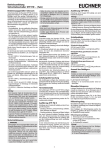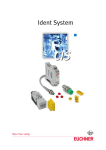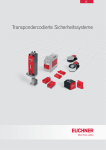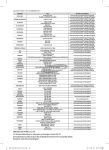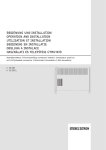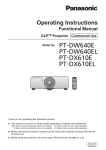Download Operating Instructions Read Head CET
Transcript
Operating Instructions Read Head CET-AX with Guard Locking and Guard Locking Monitoring Correct use Safety precautions Series CET-AX read heads are operated in combination with an evaluation unit in the system family CES-AZ. In this combination the read head CET-AX is an electromagnetic interlock device with guard locking and guard locking monitoring. Safety components fulfill personal protection functions. Incorrect installation or tampering can lead to fatal injuries to personnel. In combination with a safety guard and the machine control, this safety system prevents the safety guard from being opened while a dangerous machine movement is being performed. For the control system, this means that ffstarting commands which cause hazardous situations must become active only when the safety guard is in protective position and the guard locking is in locked position. The locked position of the guard locking must be released only when the hazardous situation is no longer present. Before safety components are used, a risk assessment must be performed on the machine in accordance with ffEN ISO 13849-1, Safety of machinery. Safety related parts of control systems. General principles for design, Annex B ffEN ISO 12100, Safety of machinery - General principles for design - Risk assessment and risk reduction ffIEC 62061, Safety of machinery. Functional safety of safety-related electrical, electronic and programmable electronic control systems. Correct use includes compliance with the relevant requirements for installation and operation, in particular ffEN ISO 13849-1, Safety of machinery. Safety related parts of control systems. General principles for design ffEN 1088, Safety of machinery. Interlocking devices associated with guards. Principles for design and selection ffEN 60204-1, Safety of machinery. Electrical equipment of machines. General requirements. The read head is only allowed to be operated in conjunction with the intended EUCHNER CET actuators and the related connection components from EUCHNER. On the use of different actuators or other connection components, EUCHNER provides no warranty for safe function. The read head CET is only allowed to be used in combination with a system family CES-AZ evaluation unit (see Table 2). ff Version CET2, guard locking by solenoid force Check the safe function of the safety guard particularly ffafter any setup work ffafter the replacement of a system component ffafter an extended period without use ffafter every fault Independent of these checks, the safe function of the safety guard should be checked at suitable intervals as part of the maintenance schedule. Fatal injury due to incorrect connection or incorrect use. Safety switches must not be bypassed (bridging of contacts), turned away, removed or otherwise rendered ineffective. On this topic pay attention in particular to the measures for reducing the possibility of bypassing from EN 1088:1995+A2:2008, Section 5.7. ff The device may be installed and put into operation only by authorized experts who are familiar with the correct handling of safety components ff who are familiar with the applicable EMC regulations ff Correct use requires observing the permissible operating parameters (see Technical data). If a product data sheet is included with the product, the information on the data sheet applies in case of discrepancies with the operating instructions. ff The PL that can be achieved depends on the installation position and the evaluation unit used. Pay attention to the information in Table 2. ff Exclusion of liability and warranty In case of failure to comply with the conditions for correct use stated above, or if the safety instructions are not followed, or if any servicing is not performed as required, liability will be excluded and the warranty void. Example: If the risk of accidental locking inside a safety guard during a power failure is higher than the risk of ineffective guard locking. The lift tappet is initially extended by spring force. The spring force on the guard locking pin is not sufficient to press down the lift tappet. Only when the guard locking solenoid is also switched on does the lift tappet retract. The guard locking is active. The guard locking operates in accordance with the open-circuit current principle. The safety door can be opened as long as the lift tappet is held in the extended position by spring force. Releases Important: The releases are not safety functions. ff The machine manufacturer must select and use a suitable release (escape release, emergency unlocking, etc.) for a specific application. A risk assessment appraisal is required for this purpose. It may be necessary to take specifications from a product standard into account. ff The releases must not be used to lock the switch during maintenance work to prevent activation of guard locking, for example. ff who have read and understood the operating instructions and the system manual. ff The switching operation must only be triggered by actuators specifically provided for this purpose (see Table 3) which are positively connected to the safety guard. ff ff Function The correct function must be checked at regular intervals. Loss of the release function due to mounting errors or damage during mounting. Check the release function every time after mounting. ff Loss of the release function due to tension on the actuator. The door must not be under tension during release. ff In the read head there is a lift tappet (1) that contains the transponder (see Figure 1). The actuator has a spring-mounted guard locking pin (2) in which there is a CES actuator. The guard locking is active if the lift tappet is retracted and the guard locking pin is in the recess (3) on the read head. Actuator Read head Observe the notes on the enclosed data sheets. ff Mechanical release and mechanical key release (can be retrofitted) The mechanical release can be used to unlock guard locking, irrespective of the state of the solenoid. Using mechanical release 1. Unscrew locking screw 2. Using a screwdriver, turn the mechanical release by around 180° in the direction of the arrow ff ff who are familiar with the applicable regulations on health and safety and accident prevention ff Important: The user is responsible for the integration of the device into a safe overall system. For this purpose, the overall system must be validated, e.g. according to EN ISO 13849‑2. The safety guard can be opened immediately in the event of interruption of the solenoid power supply! Usage only in special cases in accordance with strict evaluation of the accident risk (see DIN EN 1088 (1995), Section 5.5)! Figure 1: Read head and actuator ff Version CET1, guard locking by spring force The lift tappet is pressed into the locked position by the force of the spring for the guard locking pin in the actuator and unlocked electromagnetically by the read head. The guard locking functions in accordance with the closed-circuit current principle. The locked safety guard cannot be opened immediately in the event of interruption of the power supply to the solenoid. The actuator's guard locking pin cannot be moved out of the recess and the door is locked in the closed position as long as the lift tappet is pressed down by the guard locking pin. When the operating voltage is present at the locking solenoid, the lift tappet is extended and lifts the actuator's guard locking pin above the edge of the recess. The safety door can then be opened. ¨¨ The safety device can be opened The mechanical release must be returned to its original position and sealed after use (for example with sealing lacquer). Using mechanical key release On devices with mechanical key release (can be retrofitted), simply turn the key to unlock. For mounting, see the mechanical key release supplement. Emergency unlocking (can be retrofitted) ¨¨ Guard locking cannot be activated, and it must Changing the approach direction not be possible to start the machine. Important: Test this before entering the danger area. Using emergency unlocking Important: The door must not be under tension when emergency unlocking is actuated. ffTurn emergency unlocking clockwise until it clicks into place. ¨¨ The safety device can be opened To reset, press the detent bolt inward using a small screwdriver or similar tool and turn the emergency unlocking back. Escape release (optional) The escape release is used to open a locked safety guard from the inside (see dimension drawing in the section Technical data). Fit escape release such that operation, inspection and maintenance are possible. Using the escape release ffPress the red release knob to the stop ¨¨ The safety device can be opened Pull the knob out again to reset. Wire front release (optional) The wire front release permits remote release of the guard locking via a pull rope. Flexible routing of the pull rope permits release of the guard locking in inaccessible installation situations. Lockout mechanism (optional) Important: The lockout mechanism is not a safety function. ff The correct function must be checked at regular intervals. ff The lockout mechanism can be used to prevent maintenance personnel from being unintentionally locked in the danger area, for example. In locked position, the lockout mechanism prevents activation of guard locking. The lockout mechanism can be secured in locking position with up to three locks. The mechanical release can still be used. Using the lockout mechanism Resetting the lockout mechanism: 1. Open the safety door if necessary 2. Remove the lock 3. Move lockout mechanism to basic position (Figure 1 A) Mounting Figure 2: Changing the approach direction Caution: Caution: Risk of damage to equipment as a result of incorrect installation. Safety switches must not be used as a mechanical end stop. Fit an additional end stop for the movable part of the safety guard. ff Protection against environmental effects A lasting and correct safety function requires that the actuating head must be protected against foreign bodies such as swarf, sand, blasting shot, etc., which can become lodged in the recess. For this purpose, the read head should be installed with the actuating head facing down. ! Observe the min. door radii (see Figure 3). Ensure that the actuator contacts the slide in the designated area (see figure below). Marks on the slide specify the prescribed approach zone. ff Note the following points: Actuator and safety switch must be easily accessible for inspection and replacement. ffThe switching operation must only be triggered by the specific actuator designated for this purpose. ffActuator and safety switch must be fitted so that ffthe actuator is positively mounted on the safety guard, e.g. by using the safety screws included. ffthey cannot be removed or tampered with using simple means. ffthe active faces of the actuator and the safety switch are parallel to each other (see Figure 3). ffthe actuator is fully inserted into the switch recess when the safety guard is closed (see Figure 3). ff Deactivate guard locking and open the safety door before using the lockout mechanism. Before entering the danger area: 1. Open the door Cover the actuating head, the actuator and the rating plate during painting work! Electrical connection The read head CET is only allowed to be used in combination with a suitable EUCHNER connection cable (see Table 1). The connection cable contains two screened cores for the signal from the read head. This screening must not be interrupted on the route to the evaluation unit or earthed at any other point (see Figure 8). All the electrical connections must either be isolated from the mains supply by a safety transformer according to IEC EN 61558-2-6 with limited output voltage in the event of a fault (PELV), or by other equivalent isolation measures. For use and operation as per the requirements, a power supply with the feature "for use in class 2 circuits" must be used. The same requirement applies to the safety outputs. 2. Press button, move lockout mechanism to locking position (Figure 1 A and B) and secure with lock (Figure C) Pushbutton ff ff Important: Locking function not active Remove the screws from the read head. Set the required direction. ffTighten the screws with a torque of 1.5 Nm. ff Safety switches must not be bypassed (bridging of contacts), turned away, removed or otherwise rendered ineffective. ffOn this topic pay attention in particular to the measures for reducing the possibility of bypassing according to EN 1088:1995.A2:2008, Sec. 5.7. Locking function active Locking function active and secured Push button and align lever A B Fit lock C Figure 1: Function of lockout mechanism EUCHNER GmbH + Co. KG Kohlhammerstraße 16 D-70771 Leinfelden-Echterdingen Tel. +49/711/75 97-0 Fax +49/711/75 33 16 www.euchner.de [email protected] Subject to technical modifications, no responsibility is accepted for accuracy of this information. © EUCHNER GmbH + Co. KG 098069-16-11/12 (translation of the original operating instructions) Operating Instructions Read Head CET-AX with Guard Locking and Guard Locking Monitoring Operating Instructions Read Head CET-AX with Guard Locking and Guard Locking Monitoring min 0 R80 74,5 ± 4 mm ! = 90° min R30 0 Anfahrbereich/ Approach Zone Figure 3: Door radii and approach zone Alternative solutions must comply with the following requirements: Service and inspection Technical data Warning: ff Read head Electrically isolated power supply unit with a max. open-circuit voltage of 30 V/DC and a limited current of max. 8 A. Loss of the safety function because of damage to the system. Electrically isolated power supply unit in combination with fuse as per UL248. This fuse should be designed for max. 3.3 A and should be integrated into the 30 V DC voltage section. ff ff In order to avoid EMC interference, the physical environmental and operating conditions at the installation site of the device must comply with the requirements according to the standard EN 60204‑1:2006, section 4.4.2 (EMC). For terminal assignment see Figure 4. ffFor detailed information see the system manual for the evaluation unit used. ff Setup and functional check Pay attention to the information in the system manual for the evaluation unit used during setup. Danger of fatal injuries as a result of faults in installation and functional check. Before carrying out the functional check, make sure that there are no persons in the danger area. ff Observe the valid accident prevention regulations. ff ff Mechanical function test The actuator must slide easily into the recess on the actuating head. Close the safety guard several times to check the function. ff Electrical function test After installation and any fault, the safety function must be fully checked. Proceed as follows: Parameter Value In case of damage, the entire device must be replaced. Material - Slide - Read head housing Stainless steel Die-cast aluminum Only accessories or spare parts that can be ordered from EUCHNER may be replaced. Installation position Any (recommendation: actuating head downward) Degree of protection acc. to IEC 60529 IP67 (screwed tight with the related mating connector) Mechanical life 1 x 106 operating cycles Ambient temperature -20 ... +55 °C Actuator approach speed, max. 20 m/min Locking force, max. 6,500 N Locking force FZh in acc. with GS-ET-19 FZh = Weight Approx. 1 kg Degrees of freedom X, Y, Z X, Y ± 5 mm; Z ± 4 mm Switching frequency 1 Hz (this value can deviate depending on the evaluation unit used. See system documentation of the related evaluation unit) Connection See Figure 4 Rated insulation voltage Ui 50 V Rated impulse withstand voltage Uimp 1.5 kV Regular inspection of the following is necessary to ensure trouble-free long-term operation: ffCheck the switching function (see section Functional check) ffCheck all additional functions (e.g. escape release, lockout mechanism, etc.) ffCheck the secure fastening of the devices and the connections ffCheck for soiling No servicing is required, repairs to the device are only allowed to be made by the manufacturer. Note: The year of manufacture can be seen in the lower right corner of the type plate. Exclusion of liability under the following circumstances incorrect use ffnon-compliance with safety regulations ffinstallation and electrical connection not performed by authorized personnel fffailure to perform functional checks. ff Fmax 1.3 = 5,000 Solenoid Connection Reverse polarity protected Solenoid operating voltage/ Solenoid power consumption DC 24 V +10% -15% Duty cycle 100 % 10 W ff Actuator Parameter Value Housing material Stainless steel Installation position Active face opposite read head Degree of protection acc. to IEC/EN 60529 IP67 2. Close all safety guards. Guard locking by solenoid force: Activate guard locking. ff The machine must not start automatically. It must not be possible to open the safety guard. Mechanical life 1 x 106 operating cycles Ambient temperature -20 ... +55 °C Locking force, max. 6,500 N Weight Approx. 0.25 kg Stroke max. 15 mm 3. Enable operation in the control system. ff It must not be possible to deactivate the guard locking as long as operation is enabled. Door radius, min. 300 mm Power supply Inductive, via read head 1. Switch on operating voltage. The machine must not start automatically. ff 4. Disable operation in the control system and deactivate guard locking. ff The guard locking must remain active until there is no longer any risk of injury. ff It must not be possible to start the machine as long as the guard locking is deactivated. ff LED Parameter Value Connection voltage 24 V ± 15 % (reverse polarity protected) Current consumption, max. 6 mA Operating Instructions Read Head CET-AX with Guard Locking and Guard Locking Monitoring This connection example applies only to the read head CET1-AX-LRA-00-50X-SA! Observe the corresponding connector assignment for your version! 24 VDC -F1 -F2 -S1 CET1-AX-LRA-00-50X-SA 6 4 UCM LED2 head Read- Actuator 095735 LED1 EUCHNER 0V UCM 3 8 1 2 7 LED2 0V 5 SH1 H11H12 0V UB J CES-AZ-AES-01B 104770 Start K2 + K1 + EUCHNER TST O1 DIA 23 24 13 14 Y1 Connected load Y2 S Feedback loop GND Important: To achieve category 3, PL e or category 4, PL e according to EN 13849-1, it is necessary to monitor the downstream contactors (realized here via PLC). This example shows only an excerpt that is relevant for connection of the CES system. The example illustrated here does not show complete system planning. The user is responsible for safe integration in the overall system. Read head Plug connector (view of connection side) CET1-AX-LRA-00-50X-SA 095735 CET2-AX-LRA-00-50X-SA 106039 CET1-AX-LDA-00-50X-SE 100399 CET1-AX-LRA-00-50F-SA 102161 CET1-AX-LDA-00-50F-SA 103750 CET1-AX-LRA-00-50X-SF 104051 M12 5 6 4 7 PIN Function Wire color Connection cable* 1 Read head data wire WH 2 Read head data wire BN 3 SH, data wire screen (Screen) 4 LED 2 freely configurable, 24 V YE 5 0V GY 6 UCM, solenoid operating voltage DC 24 V PK 7 0 V UCM, solenoid operating voltage 0 V BU 8 FE function earth RD 1 Read head data wire WH 2 Read head data wire BN 3 SH, data wire screen (Screen) 4 LED 2 freely configurable, 24 V YE 5 LED 1 freely configurable, 24 V GY 6 UCM, solenoid operating voltage DC 24 V PK 7 0 V UCM, solenoid operating voltage 0 V BU 3 1 2 8 CET1-AX-LRA-00-50X-SA-C2333-111917 111917 CET1-AX-LRA-00-50F-SA-C2333-111918 111918 CET2-AX-LRA-00-50X-SA 106039 M12 5 6 CET1-AX-LRA-00-50L-SA 104062 4 7 3 1 2 8 2 x M8 CET1-AX-LRA-00-50X-SC 102988 S1.4 S1.3 S1.1 CET2-AX-LRA-00-50X-SC 109932 CET1-AX-LDA-00-50X-SC 103444 8 FE function earth RD S 1.1 Read head data wire BN S 1.3 Read head data wire WH S 1.4 SH, data wire screen (Screen) S 2.1 UCM, solenoid operating voltage DC 24 V BN S2.2 S2.4 S 2.2 0V WH S2.1 S2.3 S 2.3 0 V UCM, solenoid operating voltage 0 V BU S 2.4 LED 2 freely configurable, 24 V BK * Only for standard EUCHNER connection cable Figure 4: Connection example and terminal assignment EUCHNER GmbH + Co. KG Kohlhammerstraße 16 D-70771 Leinfelden-Echterdingen Tel. +49/711/75 97-0 Fax +49/711/75 33 16 www.euchner.de [email protected] Operating Instructions Read Head CET-AX with Guard Locking and Guard Locking Monitoring Sheath Plug connector Cable length [m] Order no. 099633 10 Straight C-M12F08-07X025PV10,0-MA-099633 099634 20 PVC C-M12F08-07X025PV20,0-MA-099634 103115 25 C-M12F08-07X025PV25,0-MA-103115 100456 10 C-M12F08-07X025PV10,0-MA-100456 Angled 105071 20 C-M12F08-07X025PV20,0-MA-105071 102218 10 PUR C-M12F08-07X025PU10,0-MA-102218 Straight 103782 25 C-M12F08-07X025PU25,0-MA-103782 Table 1: Ordering table connection cables Read head/ order number Evaluation unit/ order number Achievable category and PL according to EN ISO 13849-1 Installation position Head upward CET.-AX-... 3 / PL e In this installation position the PFHd value of the system (evaluation unit + read head) reduces to 4.29 x 10-8 Head downward CES-AZ-.ES-... 4 / PL e In this installation position the PFHd value for the system (evaluation unit + read head) is the same as that for the evaluation unit or horizontal 095735 CET1-AX-LRA-00-50X-SA 100399 CET1-AX-LDA-00-50X-SE 104051 1) CET1-AX-LRA-00-50X-SF 104062 CET1-AX-LRA-00-50L-SA 102161 CET1-AX-LRA-00-50F-SA 103750 CET1-AX-LDA-00-50F-SA 111917 CET1-AX-LRA-00-50X-SAC2333-111917 111918 CET1-AX-LRA-00-50F-SAC2333-111918 106039 CET2-AX-LRA-00-50X-SA 102988 CET1-AX-LRA-00-50X-SC 103444 CET1-AX-LDA-00-50X-SC 109932 CET2-AX-LRA-00-50X-SC 096327 CET-A-BWK-50X 073456 M5x16/V100 1) Plug connector can be rotated by 360°. Table 3: Ordering table read heads and actuators 1) Actuator, locking force 6,500 N (incl. safety screws) Safety screws M5 x 16 for actuator (replacement), packaging unit: 100 ea. 2 LEDs (2 freely configurable) 2 LEDs (1 freely configurable) Lockout mechanism Escape release Double insertion slide Single insertion slide 2 plug connectors M8 Plug connector M12 Open-circuit current principle Order no. / item Closed-circuit current principle Table 2: Combination options Operating Instructions Read Head CET-AX with Guard Locking and Guard Locking Monitoring 42 30 M8 M12 x 1 M 12 x 1 M8 ∅6.5 for M6 screw DIN 1207 / ISO 4762 24 16 16 66,7 5 66,7 CET1-AX-LRA... 51,7 51,7 90,1 75 4 25 25 8 11 <15> 43,6 90,1 CET1-AX-LDA... Active face Read head 34 34 <15> 16 <15> 28 28 17,5 15 74,5 ±4 17,5 5 20 166 Mechanical release 15 12 LED 1 red 166 130 130 LED 2 green 10 13,4 13,5 42 Version 30 CET.-AX-LRA-... Single insertion slide 25 25 Actuator CET-A-BWK-50X 10,5 26,5 Figure 5: Dimensions with plug connector M12 Figure 6: Dimensions with 2 plug connectors M8 With mechanical key release With emergency unlocking With front wire release 30,4 25 35,5 15,5 30,5 Ø 20 5,8 M12 x 1 83 16,7 30 71 M8 M12 x 1 With escape release With lockout mechanism 13,5 M8 <15> 20 16 <15> 24 140 12 Norm. position escape release Release by pressing 10 42 43,6 51,7 85 75 8 4 Figure 7: Dimensions with mechanical key release, emergency unlocking, front wire release, escape release and lockout mechanism EUCHNER GmbH + Co. KG Kohlhammerstraße 16 D-70771 Leinfelden-Echterdingen Tel. +49/711/75 97-0 Fax +49/711/75 33 16 www.euchner.de [email protected] Operating Instructions Read Head CET-AX with Guard Locking and Guard Locking Monitoring Shield (SH1) To PLC/Power Supply 3 cm H11 H12 24V Data Cable (H11/H12) SH 0V CE S TS T OU T ER R GN D 13 Figure 8: Connection to meet EMC requirements 14 23 24








